We all know them in loss of life. We all know how they died, a few of what they ate, how they grew, the place they could have roamed, and even when they suffered from illness or damage. Preserved bones can inform us lots, however maybe simply as fascinating are the tales they left in traces, the place their habits, even for one second, is captured in stone. Hint fossils—issues like preserved footprints, scat, and nests—supply an intimate view to creatures that not inhabit this planet, demonstrating that historical life might have been majestic, ferocious, and nimble, however it additionally had its mishaps, and it might be simply as bizarre and disgusting as life at the moment.
Clumsy Giants
Take sauropods. Their measurement alone evokes photos of grandeur, a view bolstered by museum shows of those monumental long-necked dinosaurs and their subsequent portrayal in movies. However absolutely there have been moments when these creatures weren’t as stately.
That is precisely what Arturo Heredia, Pablo Pazos, and Diana Elizabeth Fernández describe in a latest paper revealed within the Geological Society, London, Particular Publications. In it, we discover proof of a younger group of sauropods slipping alongside a tidal channel 130 million years in the past.
Their footprints had been on Rayoso Hill within the Neuquén Province. It’s only one a part of a wealthy Decrease Cretaceous unit inside Argentina referred to as the Agrio Formation, and it’s stuffed with exceptional and copious hint fossil preservation. At Rayoso Hill, the small print from this tidal flat ecosystem are astounding, together with water top marks, a big collection of preserved sedimentary ripples from an historical flood tide, and an historical horseshoe crab (xiphosurid) mating ground. Primarily based on the scale and form of the footprints, the staff decided these had been younger sauropods of assorted ages strolling and slipping parallel to a tidal channel.
What these footprints really had been was not instantly obvious. The staff dominated out feeding traces of enormous marine reptiles akin to plesiosaurs or ichthyosaurs. Feeding traces could be deeper at one finish, which isn’t seen in these tracks. Furthermore, the quantity of water out there within the final set of tracks would make it unlikely that an aquatic creature (fish or marine reptile) may make them. Nor had been they fish resting or fish predation traces for a variety of causes: the morphology doesn’t match, there isn’t any proof of sediment excavation as there could be with predation, and most fish wouldn’t be heavy sufficient to make that type of hint. Theropods or sauropods, alternatively, would have been. It was simple to dismiss theropods, nonetheless, because the footprints weren’t three-toed, as bipedal theropods are recognized to be. Crescent-shaped prints, the hallmark of sauropods, might be discovered amongst them, and this was the most important clue.
G/O Media might get a fee
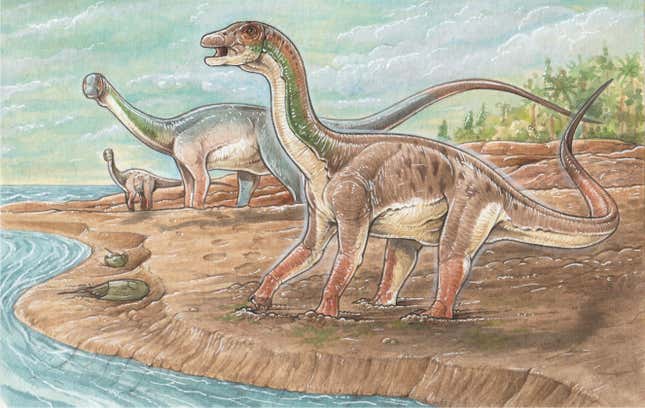
Analyzing a number of the sediments inside the footprints with a scanning electron microscope, they decided the rationale this group of younger sauropods misplaced their footing was as a result of a slippery microbial mat. These layered blankets of microorganisms akin to cyanobacteria additionally exist at the moment. Not solely did it trigger these dinosaurs to slide, however that microbial mat—together with the surroundings of that tidal flat—might have additionally helped protect their footprints. However how?
Arturo Heredia is lead writer on this paper and a CONICET postdoctoral fellow on the Instituto de Estudios Andinos Don Pablo Groeber (IDEAN). Contemplate, Heredia defined in a video interview, the assorted methods during which at the moment’s footprints might or will not be preserved when strolling alongside a seashore. Stroll too near the water, and the power of a wave or tide can erase them. Too far up into dry sand, and wind or unfastened sand grains fail to maintain the footprint form intact. However strolling simply shut sufficient to the water, the place the sand is neither too dry nor too moist, and the footprint will retain its form. This, he stated, holds true for historical traces as nicely. “The water content material in sediment,” he defined, is “vital to protect the footprint morphology.”
Humidity is equally vital for the expansion of microbial mats. Some cyanobacteria include filaments, and “they entice the sediments like a mesh,” he stated, in order that if one thing like a sauropod walks alongside this microbial mat and slips, these footprints will retain their elongated form, due to the binding of grains inside these mats. By doing so, he added, this gives “sufficient time for them to be coated by sediment and proceed on the way in which to being preserved within the fossil report.”
Microbial mats definitely assist hint fossil preservation, however, based on co-author Diana Elizabeth Fernández, a CONICET researcher additionally at IDEAN (CONICET-UBA), extra hint fossils are preserved with out them. The previous twenty years, she stated in a video interview, have elevated our understanding of microbial mats in relation to hint fossils, together with the truth that microbial mats “are extra frequent than we used to suppose.” Notably, she added, microbial mats “assist in the standard of preservation. And on this case, they had been obligatory, in fact, for this floor to be slippery in itself.”
Her former PhD advisor and co-author on the paper, Pablo Pazos, was the primary to see the tracks about 10 years in the past as she was learning the close by horseshoe crab traces. “He has an especially acute eye,” she stated. “Moreover working in ichnology, he’s a sedimentologist, so his background is geology. He’s superb at particulars. We had been fortunate, as a result of we had been working there on the time the place the solar would hit that floor with a sure angle. And you would see all the pieces accentuated. Each aid accentuated. We didn’t know what they had been, however we knew that it was positively one thing that was clumsy!”
A Predator’s Slip?
Clumsiness definitely wasn’t particular to sauropods, and potential proof of that was discovered off the coast in Yorkshire, UK. Thousands and thousands of years earlier than the younger group of sauropods even existed, an infinite theropod—a bipedal dinosaur predator—left one massive and distinctive footprint. It has the three toe prints and claws of a theropod, however the heel stretches a lot farther again, an extension not seen in different comparable footprints. The authors of a paper revealed within the Proceedings of the Yorkshire Geological Society supply three potential explanations: 1. This dinosaur might have been crouched low or laying upon the bottom in a resting place, 2. It might be the hint of the dinosaur because it slid ahead from a squatting place, or 3. This can be proof that it slipped. With just one footprint, it’s exhausting to establish something definitively.
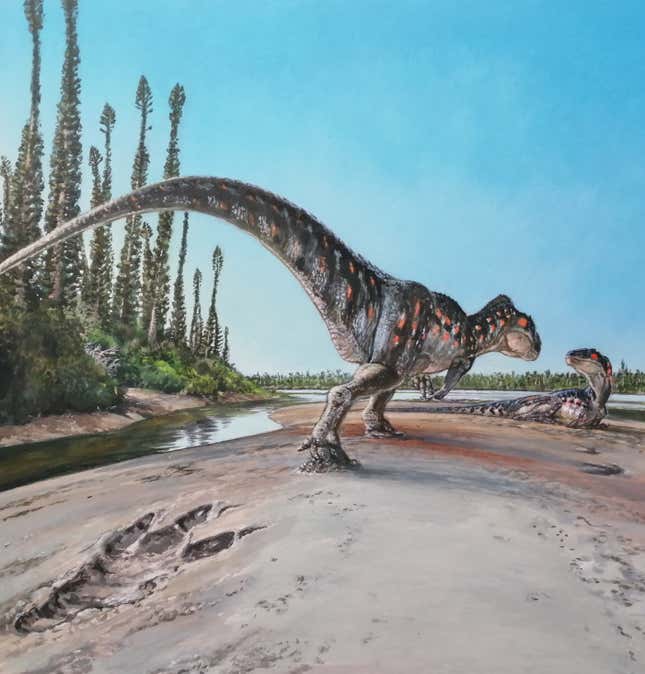
However even that one hint fossil presents tantalizing details about the animal that made it. Pores and skin impressions are preserved suggesting padded toes, and, based mostly on the scale of the footprint, they will estimate the hip top: a terrifying 2.5 to three meters (roughly 8 to virtually 10 toes).
“It could have weighed within the area of 1.5 – 2 tonnes,” lead writer and geologist John Hudson defined by e mail. This factors to the carnivorous Megalosaurus because the potential print maker, a dinosaur that lived in England throughout the Center Jurassic round 165 million to 175 million years in the past. This explicit animal would have been roughly 6 to eight meters (about 19 to 29 toes) lengthy.
“This,” Hudson stated, “could be the highest predator on the time.”
And, just like the sauropod prints, this footprint was present in a comparatively moist surroundings, in an space the place “there was by no means one essential river system however a number of meandering distributary channels with overbank deposits, sheet flood occasions, and crevasse splays,” Hudson defined. Fossil pollen and spores point out this space was residence to a variety of conifers and vegetation. These particulars about this ecosystem, one which Hudson says “doesn’t exist anyplace on this planet at the moment,” supply thrilling perception into an historical world.
“Once we examine physique fossils of extinct animals, we will by no means make sure typically if they’re in situ,” Hudson acknowledged. “With hint fossils, they’re usually preserved the place the animal walked, so after we examine a web site, each potential line of proof is taken under consideration, physique fossils, hint fossils, any surroundings clues like native flora to offer us a extra full view of the location on the time it existed.”
Creased Pores and skin
Though clumsiness was not a think about footprints discovered within the Boskovice Basin within the Czech Republic, what is completely exceptional is that they, too, left pores and skin impressions. Additionally they supply proof of species which have, to date, left no physique fossils within the space. These are hint fossils from animals that lived throughout the early Permian, roughly 293 million to 299 million years in the past. In different phrases, from a distance in time that’s staggeringly tough to fathom, paleontologists now know that these four-legged creatures (or tetrapods) existed within the space and have an thought of what the pores and skin on the soles of their toes regarded like.
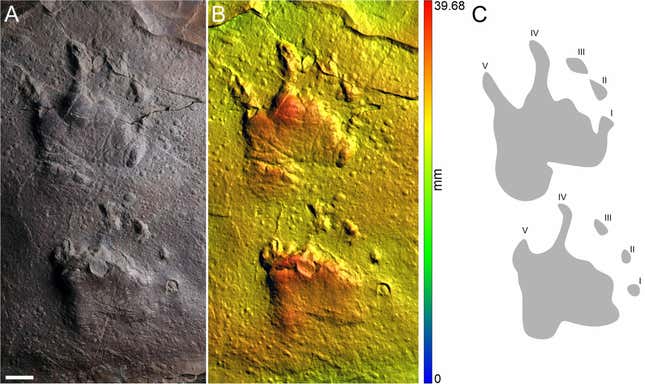
In a paper revealed in Scientific Stories, the staff describes three units of footprints, together with a trackway, from completely different areas inside the Czech Republic. Hint fossils are notoriously tough to match to the species that made them, so ichnologists—those that examine ichnofossils, one other phrase for hint fossils—will title the hint itself based mostly on its form and measurement. “Each ichnologist tries to determine the closest potential trackmaker,” Gabriela Calábková, lead writer and paleontologist on the Moravian Museum, wrote in an e mail to Gizmodo. “Sadly, it’s usually virtually unattainable to find out a specific trackmaker on the species or genus degree, not solely as a result of it’s usually not preserved within the fossil report, but additionally as a result of completely different species can depart an identical footprints.”
The staff narrowed it all the way down to an early-diverging synapsid—a forerunner to mammals—and decided the prints had been made by species whose physique lengths would have been about 13 to fifteen inches lengthy. However that, Calábková defined, doesn’t embrace the tail, head, or neck. And whereas, in comparison with theropods and sauropods, it may appear tiny, “they weren’t so small for his or her time,” she stated.
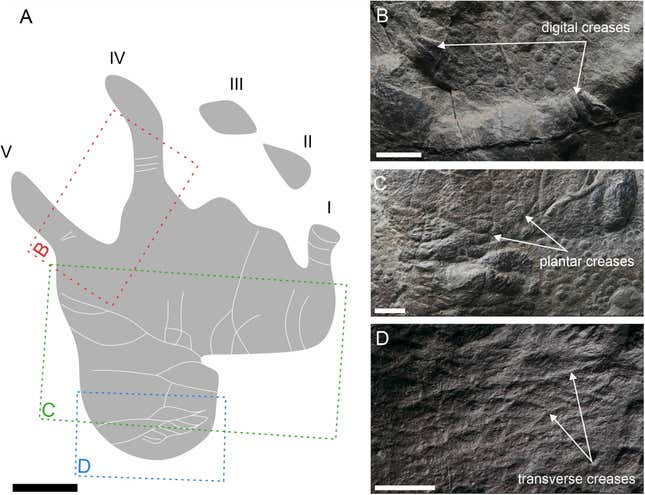
These synapsids “had a sprawling posture; they weren’t sprinters,” she asserted. “The erect posture permitting extra environment friendly and quicker motion on land appeared solely of their therapsid descendants.”
These and different not too long ago studied traces are vital, based on Calábková, for they’ve “fully modified our current concepts concerning the variety of terrestrial tetrapods within the earliest Permian of the Czech Republic.”
“It began in 2018,” she continued, “when a fossil digger and my good buddy Tomas Viktorýn introduced me small traces of reptiles he had simply discovered within the Boskovic Basin. Though these tracks weren’t nicely preserved, I used to be very , as a result of I suspected that they’d been left by animals not but recognized from the Boskovice Basin. Since then, my colleague Dr. Jakub Březina from the Moravian Museum, paleo digger Tomáš Viktorýn, and I’ve carried out a number of fieldwork, the place we’ve managed to seek out footprints not solely of synapsids but additionally of early reptiles, massive seymouriamorphs, diadectomorphs (the primary herbivorous tetrapods), and huge temnospondyls. It’s wonderful when you’ll be able to flip hours of exhausting work in muddy and really inaccessible terrain right into a discovery that brings one thing fully new to our area, akin to the primary pores and skin impression on the palms and toes of an early-diverging synapsid.”
Yuck—a Snack Sesh Gone Fallacious
Hint fossils aren’t simply made alongside moist environments; they may also be created inside the water itself. Papers revealed in 2010 and 2015 supply stunning perception into marine creatures which will have merely been trying to find a meal however as a substitute bit into one thing significantly much less interesting.
Proof present in three coprolites, or fossilized feces, reveal that historical sharks and an historical gar—a sort of long-snouted toothed fish—bit into them after which launched them. Because the authors notice, the truth that the coprolites exist is proof they weren’t consumed, however why would animals have bitten them within the first place?
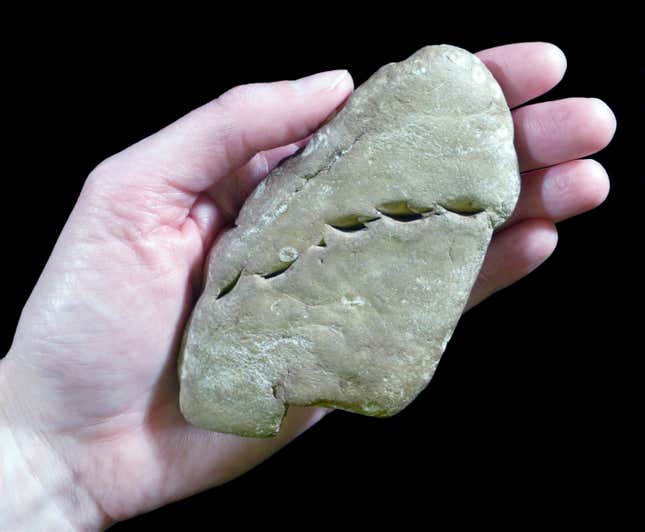
The staff thinks the sharks might have chomped down to find out whether or not the coprolites had been potential meals, solely to right away spit them out. This habits of test-biting is thought in at the moment’s sharks. However the different risk is intriguing: may the coprolite have been a part of the prey’s intestines when the shark attacked? If that’s the case, the chew mark would have remained because the coprolite left the physique from an open wound, falling to the ocean flooring the place it was ultimately coated by the sediment and preserved. These coprolites had been discovered close to rocks dated to the Miocene, roughly 5 million to 23 million years in the past.
Courting the gar-bitten coprolite was unattainable, because it was present in a deposit from blended time durations. Trendy-day gars are recognized to ambush their prey. Utilizing modeling clay, the staff replicated the forms of marks on this coprolite utilizing the enamel of an extant gar. If historical gars additionally ambushed supposed meals, then it’s potential that it was putting at prey and both missed or unintentionally included the feces as nicely. Just like the shark-bitten coprolites, it wasn’t consumed.
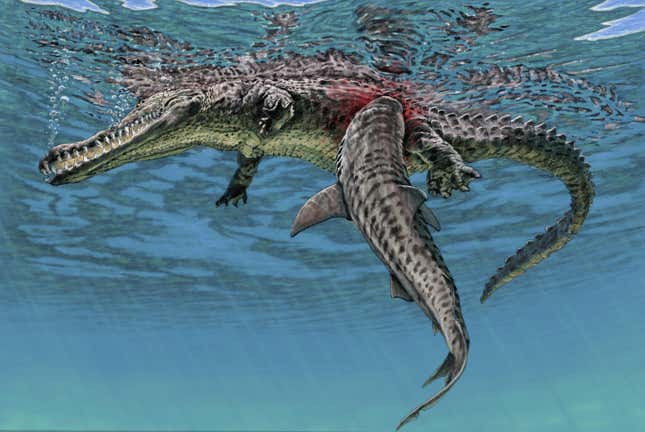
The lead writer of each papers, Stephen J. Godfrey, is curator of paleontology on the Calvert Marine Museum. These fossils, he stated, are examples of “exceedingly uncommon” composite hint fossils: a hint fossil inside a fossil (on this case, coprolites with chew marks on them).
“For me,” he stated, “the sheer improbability of this type of composite hint fossil forming and being preserved is probably the most thrilling facet of all of it. What it demonstrates is that proof of exceedingly unlikely occasions may be preserved within the fossil report. So what’s the restrict of what might be preserved…?”
The Social Lives of Fish
Not all water traces are doubtlessly stomach-turning. Scientists in Argentina found the astonishing traces of fish from the Paleozoic, roughly 419 million to 443 million years in the past. These hint fossils are described in a paper revealed in Palaios. As talked about beforehand, ichnologists will title the hint fossil itself, as the precise hint maker is commonly unknown. This staff named a brand new ichnofossil, Raederichnus dondasi: tear-drop formed fish resting traces that present the primary and oldest proof of shoaling habits, or fish congregating in teams. The title derives from “raedera,” the title for a stone software made by Indigenous Pampean hunter-gatherers in Paleolithic South America; “ikhnos” or hint from Greek; and “dondasi” from Alejandro Dondas, a area technician and self-taught paleontologist.
Raederichnus dondasi seems to be the traces of agnathan, or jawless, fishes that had been resting in a shallow, subtidal zone. The staff narrowed down potential fish behaviors to both replica or feeding. Copy appeared unlikely, due to the surroundings during which these traces had been discovered and due to the spacing of every fossil from the others. And though historical horseshoe crabs are well-known inside the Paleozoic, additionally they make very distinctive traces, none of which appear like Raederichnus dondasi.
Lead writer Karen Halpern is a paleontologist on the Universidad Nationwide de Mar del Plata.
“I had many doubts after I first noticed these fossils,” she wrote to Gizmodo, explaining that figuring out what these hint fossils could be concerned a whole lot of remark and contemplation. “My colleagues helped me in some ways, by discussing and arguing about many different potentialities. Once we lastly discarded the truth that horseshoe crabs had been unlikely to be their producer, we added a fish specialist to the staff, Soledad Gouiric-Cavalli. She was very enthusiastic about it!!”
“Most fish,” Halpern famous, “make nests in additional quiet environments,” notably people who would forestall predators from accessing them, akin to “a river mouth the place salinity is so low that no different marine predator (akin to arthropods or an octopus) can dwell.”
That these traces had been spaced out from one another was one other vital clue. This feeding habits prevents competitors.
“I hope that comparable findings can occur elsewhere!” she added, “And if within the close to future extra proof arises and our interpretation is improper, I hope somebody takes the time to put in writing it down and publish it! That’s how science works!”
An Historical Dying March
The overwhelming majority of traces require substantial detective work to grasp what might have left that fossil. However there are thrilling and astonishing fossils the place the tracemaker may be discovered inside it (as in a burrow), for instance, or on the finish of it (as in a trackway). Thousands and thousands upon tens of millions of years after the fish left shoaling traces, an historical horseshoe crab (limulid) not solely left its signature traces strolling alongside a seabed, however it then died and remained completely preserved on the very finish of these tracks.
This astonishing fossil is 9.7 meters (roughly 31 toes) in size, and was initially discovered inside the Solnhofen limestone beds in Bavaria, Germany, earlier than making its residence within the Wyoming Dinosaur Middle within the U.S.

At solely 12.7 centimeters, this arthropod is believed to be a juvenile. And though there isn’t any option to know for certain, the researchers consider this little horseshoe crab might have been tossed into this poisonous lagoon by a turbulent storm. Proof suggests this was an space missing oxygen and marked by excessive salinity, a deadly mixture for many residing issues. Whereas there are different well-preserved mortichnias—the title for hint fossils that report a creature’s loss of life march—in limestones additionally found close to Solnhofen in Bavaria, nothing else disturbed the ocean flooring; it was virtually fully devoid of life.
This explicit mortichnia tells a really unhappy however fascinating story. Step-by-step, the horseshoe crab walks, modifications route, crawls ahead, and at last dies by asphyxiation. The staff notes that, of the opposite fossils from the Solnhofen beds that present comparable loss of life marches, horseshoe crabs lasted longer than most. Crustaceans and bivalves succumbed inside decimeters and centimeters. The staff interprets a number of the extra erratic tracks as proof the horseshoe crab was confused and distressed.
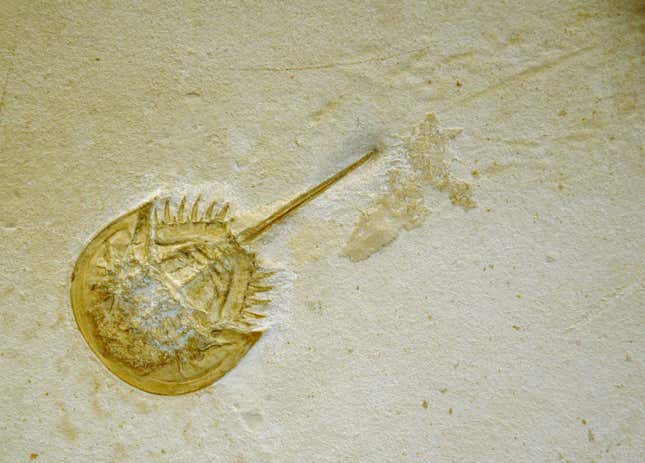
Dean Lomax, co-author on the aforementioned theropod monitor paper, paleontologist, scientific communicator, and writer, is lead scientist on this 2012 paper revealed in Ichnos.
“This is among the most spectacular fossils I’ve ever seen,” he wrote in an e mail. “I used to be really launched to this gorgeous fossil on my very first day volunteering on the Wyoming Dinosaur Middle in 2008, aged 18.”
He described how he had paid to journey from Doncaster, England to Wyoming by promoting his possessions. Even, he stated, his “cherished Star Wars assortment.” He volunteered there for 4 months and returned years later particularly to check that juvenile horseshoe crab.
“Learning this lovely fossil, nonetheless, you can’t assist however really feel some unhappiness for the little limulid who died in such tragic circumstances. But in loss of life,” he noticed, “this historical arthropod grew to become a rare story respiratory new life into learning fossils.”
“The fossil left such an enduring impression,” he continued, “that it gave me the concept for a ebook that centered on distinctive fossils with proof of habits, in the end resulting in Locked in Time – Animal Conduct Unearthed in 50 Extraordinary Fossils.”
His partaking book consists of extra details about this mortichnia, in addition to many extra phenomenal physique and hint fossils from varied geologic time durations.
Each single one in all these discoveries enriches our understanding of previous life on this Earth. Most of the creatures described above don’t have any fashionable analogue; they’re introduced again to life by way of analysis, museums, books, and our imaginations in paleoart and CGI. A few of them are to date again in time and so comparatively unknown to these of us in most of the people that they’re exhausting to image. However these behaviors aren’t. A shuffling group of younger sauropods slipping, a seemingly terrifying theropod dropping its footing: These are actions we will comprehend. The extra hint fossils discovered and interpreted, the extra items of the puzzle we put collectively, the extra relatable extinct creatures turn out to be.
Godfrey talked about that “we are going to by no means attain the tip of the tales fossils can inform.”
It’s an exquisite thought. Maybe by way of extra tales, we are going to study that life on this planet, regardless of how international or distant to us at the moment, will not be so completely different in spite of everything.
Jeanne Timmons (@mostlymammoths) is a contract author based mostly in New Hampshire who blogs about paleontology and archaeology at mostlymammoths.wordpress.com.
Trending Merchandise

Cooler Master MasterBox Q300L Micro-ATX Tower with Magnetic Design Dust Filter, Transparent Acrylic Side Panel…

ASUS TUF Gaming GT301 ZAKU II Edition ATX mid-Tower Compact case with Tempered Glass Side Panel, Honeycomb Front Panel…

ASUS TUF Gaming GT501 Mid-Tower Computer Case for up to EATX Motherboards with USB 3.0 Front Panel Cases GT501/GRY/WITH…

be quiet! Pure Base 500DX Black, Mid Tower ATX case, ARGB, 3 pre-installed Pure Wings 2, BGW37, tempered glass window

ASUS ROG Strix Helios GX601 White Edition RGB Mid-Tower Computer Case for ATX/EATX Motherboards with tempered glass…










